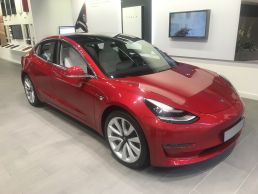Considering what vehicle to have next - electric dreams or a reality?
Do you remember the BBC TV Series Tomorrow’s World, which ran from 1965 to 2003? If you are too young, watch some old clips when you get a minute. It often showed some future tech that was laughable and a lot of it never even made it into mainstream use.
You will have all heard a lot of noise recently regarding the large scale and Worldwide investment and production of Hybrid and Electric Vehicles (EV’s) whether it be positive, negative or some headline grabbing news feeds on your phone just giving you a snapshot of half a story.
Below are some comprehensive and very important details, from that initial phase of looking into what is the current situation from a tax perspective, treatment of pence per mile, EV charger installation and what it means to you. Whether like me, you are a company car user as a Director of a Company or an employee of a business, self-employed, or if you are a fleet manager considering the options next time you change your vehicle. I do hope you find the information of use.
All I would say to anyone considering it, is do your research and lots of it, then go and see one you are considering and book a test drive. You are then that extra step closer to making your OWN mind up and knowing all the facts!

Before I share my views in future posts on cost, plug in grants, ownership, leasing, performance, logistics and even the psychology of making this switch, I thought it best to start at the beginning of this process, which was the (boring but necessary) research of what are the main tax implications of making these changes, which is where many people are currently at when considering what vehicle to have next.
Rebecca Cave explains the tax treatment of low emission vehicles
The government’s aim is to encourage more people to use low CO2 emission or zero emission vehicles and there are a number of tax measures that incentivise that behaviour. However, those tax measures are not all perfectly aligned, as different emissions thresholds and cut-off dates apply for capital allowances, leasing costs, employee benefits and optional remuneration arrangements (OpRA).
This article outlines the various tax incentives for low emission vehicles as they apply in 2019/20 to 2022/23.
Capital allowances
Cars do not qualify for the annual investment allowance (AIA), even if they have low CO2 emissions. However, the cost of acquiring any commercial vehicles can be claimed under the AIA, so it is important to determine whether a vehicle qualifies as a commercial vehicle for tax purposes. The AIA cap is £1m for purchases made in the calendar years 2019 and 2020, and is due to revert to £200,000 on 1 January 2021. An announcement on the new AIA cap is expected in the Budget on 11 March 2020
Until 1 April 2021 (5 April 2021 for income tax) a low emissions car can qualify for a 100% first year allowance (FYA) if its CO2 emissions do not exceed 50g/km and the car is purchased new and unused (s45D, Capital Allowances Act 2001 (CAA 2001)).
A similar 100% FYA apples for zero emission vans, where the vehicle is purchased new and unused before 1 April 2021, or 5 April 2021 for income tax (s45DA, CAA 2001). However, as all commercial vehicles qualify for 100% relief under the AIA, this special FYA for zero emission goods vehicles is not needed by the majority of businesses.
Cars with CO2 emissions of between 51g/km and 110g/km are added to the main pool for capital allowance purposes, so attract an annual writing down allowance (WDA) of 18%. Cars with CO2 emissions exceeding 110g/km must be allocated to the special rate pool, where the WDA is 6% (s56, CAA 2001). A hybrid rate of WDA between 8% and 6% applies for the special rate pool for accounting periods that straddle 1 or 6 April 2019.
Benefits-in-kind
The percentage of list price of a company car which is taxed as a benefit is determined by the CO2 emissions of the vehicle. For 2019/20 low emission cars (up to 50g/km) are taxed at 16% of list price, or 20% for diesels. The list price includes the cost of any optional accessories but does not include any discount negotiated with the dealer, so the taxable list price may significantly exceed the actual amount paid for the vehicle.
Hybrids encouraged
From 6 April 2020 the car benefit rules will be amended to encourage the provision of electric cars and hybrid vehicles. The appropriate percentages for cars with CO2 emissions of up to 50g/km will take into account the range for which the car can be driven with zero emissions. This will normally mean electric-only power, but it can also apply to hydrogen power.
However, the calculation of the taxable benefit will be made more complex due to a switch in the methods used for measuring CO2 emissions, from the New European Driving Cycle (NEDC) measure to the Worldwide Harmonised Light Vehicle Test Procedure (WLTP), which also takes effect from 6 April 2020. The CO2 emissions measured under WLTP tend to be higher than those determined by the NEDC method.
To compensate for this sudden jump in recorded CO2 emissions, the percentage of list price for most cars first registered on and after 6 April 2020 is reduced by two percentage points. This means there will be two parallel tables to calculate car benefit for 2020/21 to 2022/23, for old (pre-April 2020 cars), and new cars (registered 6 April 2020 onwards)
However, there is a further exception for zero-emissions cars, ie purely electric cars which produce no CO2 emissions at all. From 6 April 2020 the taxable benefit for all electric cars will be reduced to zero, irrespective of when the car was registered.
A third complication is that the percentage of list price for all “new” cars and all electric cars will increase by one percentage point in 2021/22 and by another percentage point in 2022/23. This should bring the old car and new car tables back in line, so we can revert to one table, assuming the Government doesn’t have other ideas by then.
Electric dream
The tax year 2020/21 will be the sweet spot for buying an electric company car, when a 100% FYA can be claimed by the company purchasing the car and the employee will not be taxed on the benefit of using the car, as all electric cars will have a 0% of list price benefit. In 2021/22 the taxable benefit of having a zero-emissions company car will be 1% of the list price and in 2022/23 it will be 2% of the list price.
OpRA out of sync
Where an employee has a car provided under an OpRA, the benefit is valued as the amount of salary given up, not as the appropriate percentage of the list price of the car. However, the OpRA rules do not apply if the company car has CO2 emissions of less than 75g/km. This is a different definition of low emissions from that used for capital allowances.
Leased cars
Where cars are leased the amount of deduction which would otherwise be allowable is reduced by 15% if the car has high CO2 emissions. In this case the threshold for ‘high’ is aligned with that for capital allowances, being over 110g/km for leases commencing on or after 1 April 2018 (6 April 2018 for income tax).
Electric vans
The taxable benefit for having the private use of an electric van is gradually being aligned with that for ordinary vans. In 2019/20 the taxable benefit for using a normal company van is £3,430 and the benefit for an electric van is 60% of that figure: £2,058. In 2020/21 the electric van will be taxed at 80% of the benefit for a normal van, and in 2021/22 at 90% (s115(1C), Income Tax (Earnings and Pensions) Act 2003). There is no taxable benefit at all if the van is only used for business journeys and ordinary commuting.
Cost of charging
Where the employer pays for the cost of charging the company-provided electric vehicle there is no taxable fuel benefit for the driver, as electricity is not classified as a fuel for the car or van benefit regulations.
Where the driver of the electric vehicle pays for the electricity to power it, either from their domestic supply or by charging at a roadside station, the employer may reimburse the employee for that cost. With a roadside charge is it easy to see what the total cost is, but it is not so easy to calculate the cost per mile when charging from a domestic supply.
This problem has been solved from 1 September 2018, as the employer can pay the company car driver 4p per mile, to reimburse them for the cost of the electricity used for business journeys, with no tax implications. This rate only applies to company-owned electric cars, not to private vehicles.
Where the employee uses his or her own electric car for business journeys the company can pay the normal tax-free mileage allowance to the individual of 45p per mile for the first 10,000 miles driven in the year, with additional business miles reimbursed at 25p per mile. The driver may also claim the passenger rate of 5p per mile for every person he or she takes on the same business journey.
Free charging at work
From 6 April 2018, where the company allows employees to charge their own electric vehicles at the workplace, there is no taxable benefit for the provision of that free electricity.
For this tax exemption to apply, the charging facilities must be provided at or near the workplace, which is the same requirement that applies to tax-free workplace parking. This tax exemption does not apply if the employer reimburses the costs of charging the employee’s own vehicle away from the workplace, such as at a motorway service station.
In common with other workplace tax exemptions, the vehicle charging facilities must be available to employees generally. If there are multiple sites, the employer does not have to provide an electric vehicle charging point at each of them.
Surprisingly the employee does not need to be the driver of the electric vehicle to benefit from the exemption; he or she may be a passenger, perhaps where the spouse or partner has driven the car to work.
Charging points
Where the business installs charging points for electric vehicles in the period from 23 November 2016 to 31 March 2023, or 5 April 2023 for income tax, it can claim a 100% FYA for those costs (s45EA, CAA 2001,). For charging points installed outside of this period the cost would qualify for the AIA.
Thanks go to Rebecca Cave, Director of Taxwriter Ltd and consultant tax editor of Accountingweb.co.uk she is fully credited with the tax details contained within this article.
Simon Moult – All Finance Solutions



